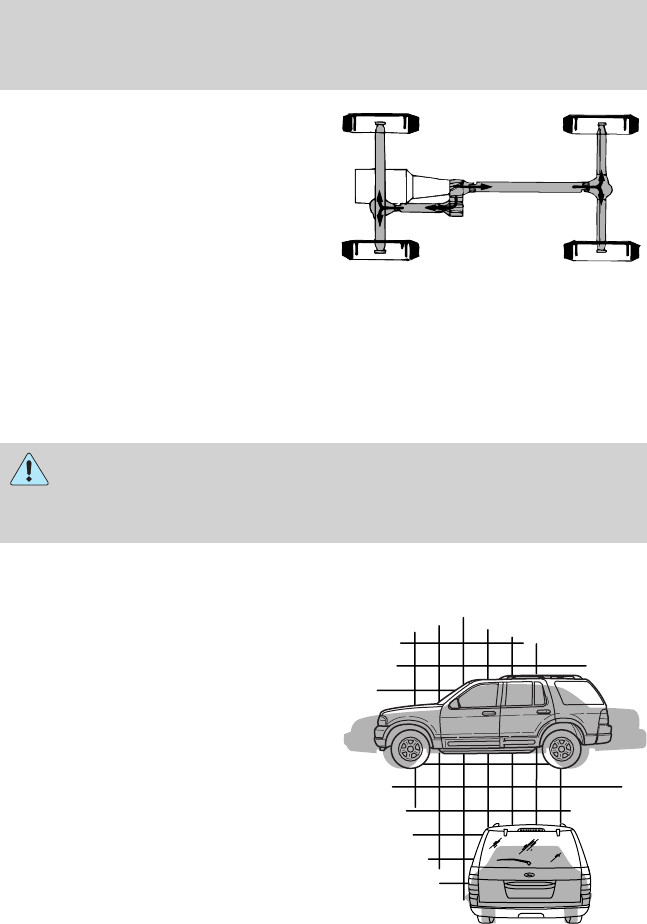Owner's Manual
Table Of Contents
- Table of Contents
- Introduction
- Instrument Cluster
- Entertainment Systems
- Climate Controls
- Lights
- Driver Controls
- MULTI-FUNCTION LEVER
- TILT STEERING WHEEL
- ILLUMINATED VISOR MIRROR (IF EQUIPPED)
- OVERHEAD CONSOLE (IF EQUIPPED)
- CENTER CONSOLE
- AUXILIARY POWER POINT (12VDC)
- POWER WINDOWS
- AUTOMATIC DIMMING REAR VIEW MIRROR (IF EQUIPPED)
- EXTERIOR MIRRORS
- SPEED CONTROL
- MOON ROOF (IF EQUIPPED)
- MESSAGE CENTER (IF EQUIPPED)
- LIFTGATE
- CARGO SHADE (IF EQUIPPED)
- LUGGAGE RACK (IF EQUIPPED)
- Locks and Security
- Seating and Safety Restraints
- FRONT SEATS
- REAR SEATS
- SAFETY RESTRAINTS
- Personal Safety System
- How does the Personal Safety System work?
- Driver and passenger dual-stage airbag supplemental restraints
- Front crash severity sensor
- Driver’s seat position sensor
- Front passenger sensing system
- Front safety belt usage sensors
- Front safety belt pretensioners
- Front safety belt energy management retractors
- Determining if the Personal Safety System is operational
- Safety restraints precautions
- Combination lap and shoulder belts
- Energy Management Feature
- Vehicle sensitive mode
- Automatic locking mode
- Safety belt height adjustment
- Safety belt pretensioner
- Safety belt extension assembly
- Safety belt maintenance
- Safety belt warning light and indicator chime
- BeltMinder
- Personal Safety System
- AIRBAG SUPPLEMENTAL RESTRAINT SYSTEM (SRS)
- Important SRS precautions
- Children and airbags
- How does the airbag supplemental restraint system work?
- Front passenger sensing system
- Determining if the system is operational
- Seat-mounted side airbag system (if equipped)
- Safety Canopy system (if equipped)
- Disposal of airbags and airbag equipped vehicles (including pretensioners)
- SAFETY RESTRAINTS FOR CHILDREN
- SAFETY SEATS FOR CHILDREN
- Tires, Wheels and Loading
- NOTICE TO UTILITY VEHICLE AND TRUCK OWNERS
- VEHICLE CHARACTERISTICS
- INFORMATION ABOUT UNIFORM TIRE QUALITY GRADING
- TIRES
- INFLATING YOUR TIRES
- TIRE CARE
- INFORMATION CONTAINED ON THE TIRE SIDEWALL
- TIRE PRESSURE MONITORING SYSTEM (TPMS)
- SNOW TIRES AND CHAINS
- VEHICLE LOADING – WITH AND WITHOUT A TRAILER
- TRAILER TOWING
- RECREATIONAL TOWING
- Driving
- STARTING
- ENGINE BLOCK HEATER (IF EQUIPPED)
- BRAKES
- STEERING
- PREPARING TO DRIVE
- AUTOMATIC TRANSMISSION OPERATION
- REVERSE SENSING SYSTEM (IF EQUIPPED)
- FOUR WHEEL DRIVE (4WD) SYSTEM (IF EQUIPPED)
- DRIVING THROUGH WATER
- Roadside Emergencies
- Customer Assistance
- GETTING THE SERVICES YOU NEED
- IN CALIFORNIA (U.S. ONLY)
- THE BETTER BUSINESS BUREAU (BBB) AUTO LINE PROGRAM (U.S. ONLY)
- UTILIZING THE MEDIATION/ARBITRATION PROGRAM (CANADA ONLY)
- FORD EXTENDED SERVICE PLAN
- GETTING ASSISTANCE OUTSIDE THE U.S. AND CANADA
- ORDERING ADDITIONAL OWNER’S LITERATURE
- REPORTING SAFETY DEFECTS (U.S. ONLY)
- REPORTING SAFETY DEFECTS (CANADA ONLY)
- Cleaning
- Maintenance and Specifications
- SERVICE RECOMMENDATIONS
- PRECAUTIONS WHEN SERVICING YOUR VEHICLE
- OPENING THE HOOD
- IDENTIFYING COMPONENTS IN THE ENGINE COMPARTMENT
- WINDSHIELD WASHER FLUID
- CHANGING THE WIPER BLADES
- ENGINE OIL
- BATTERY
- ENGINE COOLANT
- FUEL FILTER
- WHAT YOU SHOULD KNOW ABOUT AUTOMOTIVE FUELS
- ESSENTIALS OF GOOD FUEL ECONOMY
- EMISSION CONTROL SYSTEM
- POWER STEERING FLUID
- BRAKE FLUID
- TRANSMISSION FLUID
- AIR FILTER
- MOTORCRAFT PART NUMBERS
- MAINTENANCE PRODUCT SPECIFICATIONS AND CAPACITIES
- ENGINE DATA
- IDENTIFYING YOUR VEHICLE
- TRANSMISSION/TRANSAXLE CODE DESIGNATIONS
- Accessories
- Index

Power is supplied to all four wheels
through a transfer case or power
transfer unit. 4WD vehicles allow
you to select different drive modes
as necessary. Information on
transfer case operation and shifting
procedures can be found in the
Driving chapter. Information on
transfer case maintenance can be found in the Maintenance and
Specifications chapter. You should become thoroughly familiar with this
information before you operate your vehicle.
On some 4WD models, the initial shift from two-wheel drive to 4WD
while the vehicle is moving can cause a momentary clunk and ratcheting
sound. These sounds are normal as the front drivetrain comes up to
speed and is not cause for concern.
Do not become overconfident in the ability of 4WD and AWD
vehicles. Although a 4WD or AWD vehicle may accelerate better
than two-wheel drive vehicle in low traction situations, it won’t stop
any faster than two-wheel drive vehicles. Always drive at a safe speed.
How your vehicle differs from other vehicles
SUV and trucks can differ from
some other vehicles in a few
noticeable ways. Your vehicle may
be:
• Higher – to allow higher load
carrying capacity and to allow it
to travel over rough terrain
without getting hung up or
damaging underbody components.
• Shorter – to give it the capability
to approach inclines and drive
over the crest of a hill without
getting hung up or damaging
underbody components. All other
things held equal, a shorter
wheelbase may make your vehicle
quicker to respond to steering inputs than a vehicle with a longer
wheelbase.
2007 Mariner (mrn)
Owners Guide (post-2002-fmt)
USA (fus)
Tires, Wheels and Loading
132










